文章信息
- 陈国峰, 刘峰, 张晓波, 廖辉, 陶波
- CHEN Guo-feng, LIU Feng, ZHANG Xiao-bo, LIAO Hui, TAO Bo
- 氯虫苯甲酰胺在大豆和土壤中的残留及降解行为
- Residue analysis and degradation dynamics of chlorantraniliprole in soybean and soil
- 农业环境科学学报, 2016, 35(5): 894-900
- Journal of Agro-Environment Science, 2016, 35(5): 894-900
- http://dx.doi.org/10.11654/jaes.2016.05.011
-
文章历史
- 收稿日期: 2015-11-06
2. 黑龙江省农业科学院农产品质量安全研究所暨农业部农产品质量安全风险评估实验站(哈尔滨), 哈尔滨 150086
2. Safety and Quality Institute of Agricultural Products, Heilongjiang Acadamy of Agricultural Sciences, The Ministry of agriculture of agricultural products quality safety risk assessment Laboratory(Harbin), Harbin 150086, China
近年来,由于高毒有机磷的禁用,一批低毒、高效的杀虫剂在我国登记并取代了有机磷的地位[1],其中氯虫苯甲酰胺(Chlorantraniliprole)便是由美国杜邦(DuPont)公司开发的一种高效、低毒、作用机制独特的新型邻甲酰氨基苯甲酰胺类杀虫剂[2, 3, 4, 5, 6, 7]。因此,开展农药田间试验,研究其在大豆和土壤中残留和消解趋势对保护环境和安全用药具有十分重要的意义。氯虫苯甲酰胺化学名为3-溴-N-{4-氯-2-甲基-6-[(甲氨基)羰基]苯基}-1-(3-氯-2-吡啶基)-1H-吡唑-5-酰胺,属广谱杀虫剂,对危害水稻、果树、蔬菜等作物的大部分鳞翅目、鞘翅目害虫具有快速、长效、广谱的防治作用[2, 3, 4, 5, 6, 7, 8, 9, 10, 11, 12, 13]。目前,国内外已报道了氯虫苯甲酰胺的检测方法[7, 14, 15],对稻纵卷叶螟、甜菜夜蛾等的药效研究[16, 17, 18, 19, 20, 21],以及其在水稻、甘蓝、番茄等作物上的残留研究[9, 22, 23, 24]。但对氯虫苯甲酰胺在大豆中的残留检测方法以及残留和消解动态在国内外均未见报道。目前,我国尚未开展氯虫苯甲酰胺在大豆上防治豆荚螟的登记工作,以及其在毛豆上MRL(最高残留限量)值的制定工作。为了提供氯虫苯甲酰胺在大豆上安全使用的技术支持和制定氯虫苯甲酰胺在毛豆上的MRL值,建立分析其在毛豆、大豆植株和土壤中残留的有效方法以及开展其在大豆田中残留模拟试验十分必要。本研究采用乙腈提取和固相萃取净化的液相色谱-串联质谱的检测技术,研究了新型杀虫剂氯虫苯甲酰胺在大豆和土壤中的残留降解动态和最终残留,以期为氯虫苯甲酰胺在大豆地的合理使用以及我国毛豆中氯虫苯甲酰胺的MRL值制定提供科学依据。
1 材料与方法 1.1 仪器设备Waters TQD型高效液相色谱三重四极杆质谱串联仪(LC-MS/MS,美国Waters公司);色谱柱Acquity UPLC®BEH C18(100 mm×2.1 mm,1.7 μm);氨基固相萃取小柱(1 g·6 mL-1);电子天平Sartorius;匀浆机IKA T18;旋转蒸发仪;过滤器(滤膜孔径约0.22 μm);常用玻璃器皿。
1.2 试剂氯虫苯甲酰胺标准品(99.5%,Dr. Ehrenstorfer公司提供);乙腈、二氯甲烷、NaCl均为分析纯;甲醇、乙酸铵均为色谱纯;去离子水(过0.22 μm滤膜)。
1.3 田间试验 1.3.1 200 g·L-1氯虫苯甲酰胺悬浮剂在大豆和土壤中的消解动态试验在供试的大豆田中,设3个重复小区,每小区面积30 m2,小区间设立保护行。施药时间为大豆生长到成熟个体一半大小时施药,施药时应保证用于动态试验的大豆均匀着药。施药剂量为制剂量30 g·hm-2(150 g ai·hm-2),施药后2 h和1、2、3、5、7、10、14、21、28、45 d采样,处理重复3次,处理间设保护隔离区,另设空白对照。随机采样,将大豆动态全株样本切碎、充分混匀后用四分法缩分样品,分取两份200 g的样品,分别装入封口样品容器中,粘好标签,于-20 ℃冰柜中保存。小区边行和每行距离两端0.5 m内不采样。
1.3.2 200 g·L-1氯虫苯甲酰胺悬浮剂在毛豆和土壤中的最终残留试验根据田间设计方案设两个施药剂量,分别为低剂量制剂量195.7 g·hm-2(36 g ai·hm-2)和高剂量制剂量293.6 g·hm-2(54 g ai·hm-2)施药,各设2次施药和3次施药两个处理,每个处理3次重复。小区面积30 m2,按照试验设计时间开始第1次施药,施药间隔期7 d。采样时间距离最后一次施药的间隔时间分别为1、3、5、7 d。另设空白对照,处理间设保护带。每小区随机采集毛豆2 kg和土壤2 kg,经混匀缩分后各留样毛豆(带荚)200 g和土壤200 g。所有样品用塑料袋封装、编号,于-20 ℃以下冰柜低温保存待测。
1.3.3 试验地点及土壤类型氯虫苯甲酰胺在毛豆上的残留试验分别在哈尔滨、石家庄和楚雄进行。试验期间哈尔滨月平均温度在14~25 ℃之间,降水量为410 mm,试验地土壤类型为黑土,pH6.41,有机质含量为3.23%;石家庄月平均气温在19~30 ℃之间,降水量为393 mm,土壤类型属于石灰性褐土,pH 7.6,有机质含量1.3%;楚雄月平均气温在16~24 ℃之间,降水量为617 mm,试验地土壤类型为红壤,pH8.1,有机质含量4.0%。
1.4 分析方法 1.4.1 前处理称取毛豆、植株、土壤样品25.0 g于250 mL烧杯中,加入乙腈∶水(1∶1,V/V)100 mL,高速匀浆2 min,过滤;滤液全部转移至含5 g NaCl的100 mL具塞量筒中,振摇5 min后静置30 min,取上清液10 mL旋转浓缩至干,加入甲醇∶二氯甲烷(5∶95,V/V)待净化;用甲醇∶二氯甲烷(5∶95,V/V) 5 mL预淋氨基固相萃取柱,将待净化液6 mL(分三次)转入柱中洗脱并收集,于氮吹仪浓缩近干,用5 mL甲醇定容,经0.22 μm微膜过滤,待测。
1.4.2 仪器条件色谱柱Acquity UPLC®BEH C18(100 mm×2.1 mm,1.7 μm);柱温35 ℃;流速0.30 mL·min-1;梯度洗脱(流动相A为甲醇,流动相B为10 mmol·L-1乙酸铵):0 min为0%A,1.5 min为80%A,3.5 min为80%A,3.6 min为10%A。进样量5 μL;电喷雾离子源ESI;正离子源扫描方式;毛细管电压3.5 kV;锥孔电压24 V;离子源温度110 ℃;脱溶剂温度450 ℃;脱溶剂气流量650 L·h-1;锥孔气流量90 L·h-1;多重反应监测(MRM)方式;母离子为483.78 D,子离子为285.98 D,锥孔电压为24 V,碰撞能量为24 eV。氯虫苯甲酰胺在此色谱条件下的保留时间为2.68 min。色谱图见图 1。
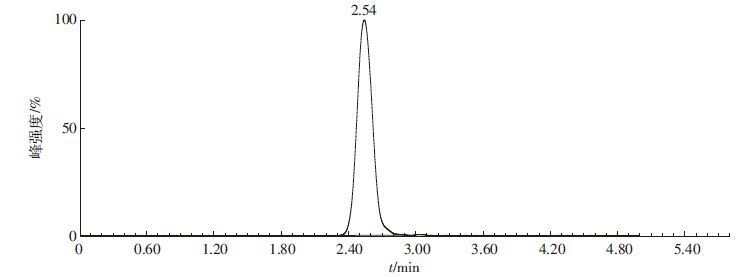
|
| 图 1 氯虫苯甲酰胺标准品(0.10 mg·L-1)色谱图 Figure 1 LC-MS/MS chromatography of chlorantraniliprole standard(0.10 mg·L-1) |
上述色谱操作条件系典型操作参数,为获得最佳效果,实际操作中根据仪器特点对给定操作参数作适当调整。
1.4.3 标准工作曲线的绘制称取氯虫苯甲酰胺标准品0.010 0 g(精确至0.000 1 g),甲醇溶解并配制成1000 mg·L-1的标准贮备液,试验时再用甲醇逐级稀释成氯虫苯甲酰胺质量浓度分别为0.05、0.10、0.20、0.50、1.00 mg·L-1的标准工作溶液。在选定的仪器条件下测定,以标准工作溶液浓度为横坐标(x)、峰面积为纵坐标(y)绘制标准工作曲线。
1.4.4 方法的回收率和精密度向空白毛豆、大豆植株和土壤中(采自哈尔滨市红旗乡的未污染样品)添加氯虫苯甲酰胺标准溶液,使样品中添加浓度分别为0.05、0.10、1.00 mg·kg-1,每个浓度进行5次重复试验,然后按照上述方法测定,计算回收率和相对标准偏差。色谱图见图 2。
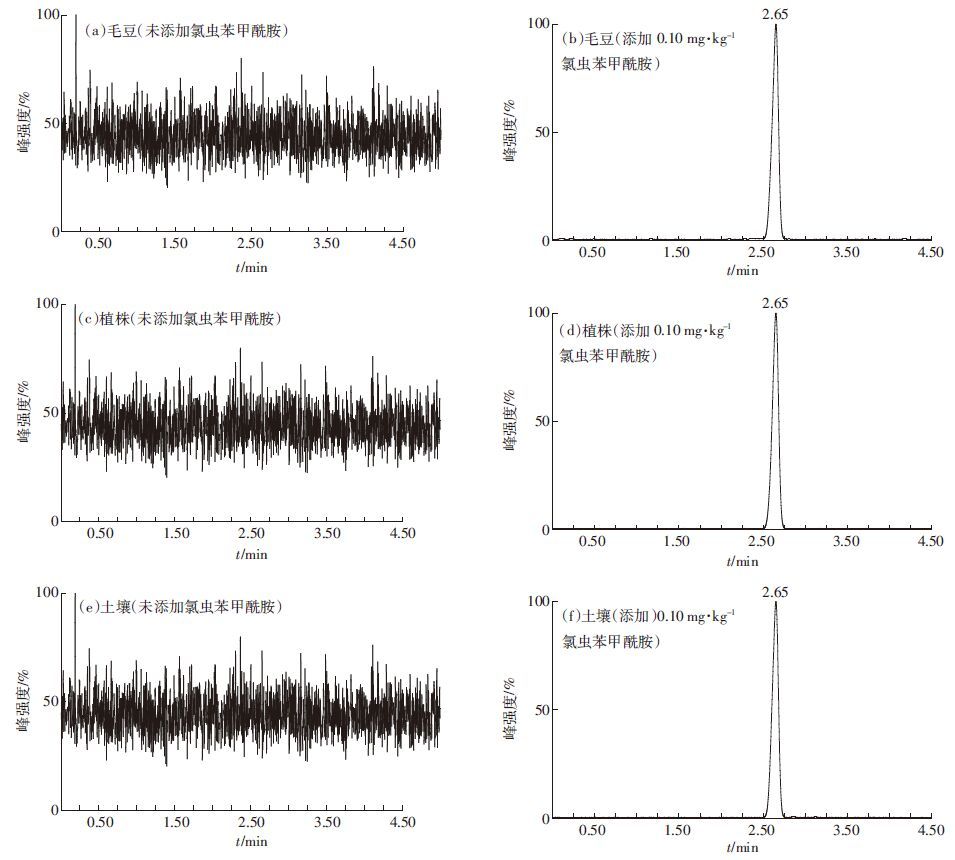
|
| 图 2 毛豆、植株和土壤样品色谱图 Figure 2 LC-MS/MS chromatography of chlorantraniliprole in vegetable soybean,soybean plant and soil |
分别用甲醇配制不同浓度的氯虫苯甲酰胺标准溶液0.05、0.10、0.20、0.50、1.00 mg·L-1,在上述检测条件下测定,线性回归方程为y=12 042x+115.63,相关系数r=0.999 3。
表 1为氯虫苯甲酰胺在毛豆、大豆植株和土壤中的添加回收率。对于3种样品的3个添加浓度5个平行样本,氯虫苯甲酰胺在毛豆、大豆植株和土壤中的添加平均回收率分别为102.0%~107.6%、102.4%~106.8%和99.8%~106.8%;变异系数分别为2.9%~7.2%、1.7%~6.4%和2.1%~3.7%,能够满足氯虫苯甲酰胺在毛豆、大豆植株和土壤中残留测定要求。试验得出氯虫苯甲酰胺的最小检出量为2.5×10-10 g,该方法在毛豆、大豆植株和土壤中的最低检出浓度均为0.05 mg·kg-1。
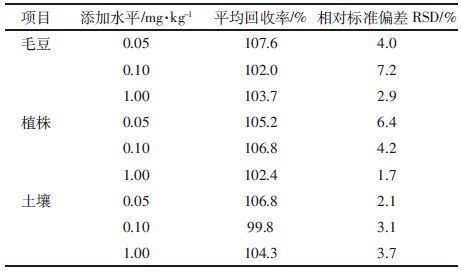 |
由图 3和表 2可见,氯虫苯甲酰胺在大豆植株和土壤中的残留量均随着时间的延长而逐渐降低,其消解过程均符合动力学一级降解模型,即Ct =C0e-kt(其中C0为施药后的原始沉积量,k为消解速率常数,t为施药后的天数,Ct为施药后经过t天的农药浓度)。氯虫苯甲酰胺在哈尔滨、石家庄和楚雄三地田间试验施药21 d后,大豆植株中氯虫苯甲酰胺的降解率分别为90.78%、73.99%和99.30%,土壤中氯虫苯甲酰胺的降解率分别为66.61%、99.08%和90.11%。氯虫苯甲酰胺在大豆植株中的半衰期为4.3~10.1 d,在土壤中的半衰期为3.1~10.2 d。这说明氯虫苯甲酰胺在大豆植株和土壤中均属于易降解农药(半衰期t1/2<30 d)。氯虫苯甲酰胺在大豆植株和土壤中的消解速率与土壤性质和试验期间的天气状况关系密切,试验期间石家庄的平均温度高于哈尔滨和楚雄,可能是导致石家庄土壤中氯虫苯甲酰胺降解速率较快的主要原因。

|
| 图 3 氯虫苯甲酰胺在大豆植株和土壤中的消解动态曲线 Figure 3 Dynamic curves of chlorantraniliprole degradation in soybean plant and soil |
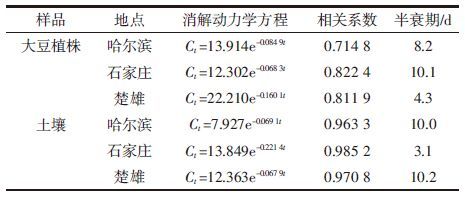 |
200 g·L-1氯虫苯甲酰胺悬浮剂在大豆上的最终残留量结果见表 3。在哈尔滨、石家庄和楚雄三地的最终残留量的结果基本相似,其规律为施药浓度越高,用药次数越多,距离最后一次施药时间越近,最终残留量也越高。以推荐剂量195.7 g·hm-2 (36 g ai·hm-2)和1.5倍推荐剂量293.6 g·hm-2(54 g ai·hm-2)在大豆上分别喷施2次和3次200 g·L-1氯虫苯甲酰胺悬浮剂后,在末次施药1、3、5、7 d后每小区随机采集毛豆和土壤样品,对样品中的氯虫苯甲酰胺按上述方法进行提取、净化和测定,结果表明:距末次施药3 d时,氯虫苯甲酰胺在毛豆中的最高残留量为0.923 mg·kg-1,在土壤中的最高残留量是0.757 mg·kg-1,均低于日本和澳大利亚规定的氯虫苯甲酰胺在毛豆中的最大残留限量(1 mg·kg-1)。说明在本试验条件下,氯虫苯甲酰胺在毛豆中的残留是安全的。最终残留试验结果表明,随着施药剂量的增大以及施药次数的增多[25],毛豆和土壤中氯虫苯甲酰胺的残留量增高,并随着采收时间的推移逐渐降低。
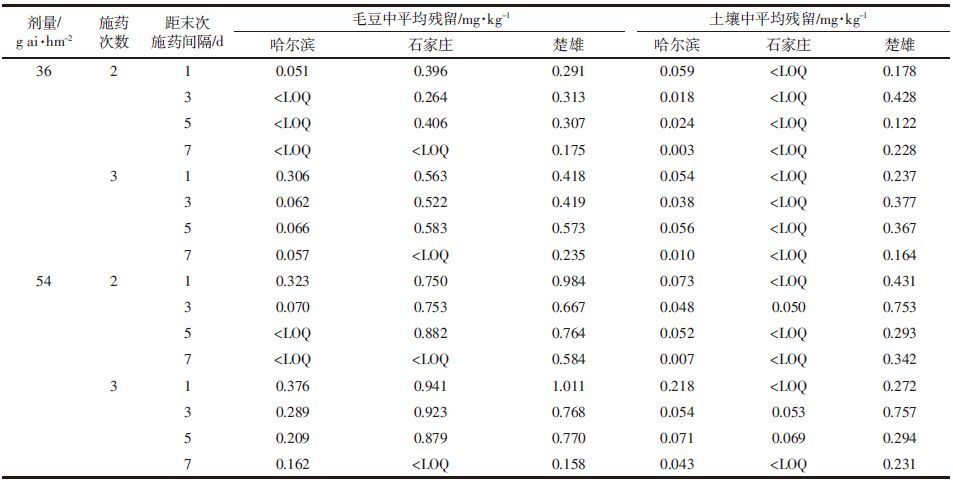 |
(1)建立了超高效液相色谱质谱联用仪测定毛豆、大豆植株和土壤中氯虫苯甲酰胺残留量的方法,该方法操作简便,准确性和灵敏度均能满足农药残留检测的要求。
(2)氯虫苯甲酰胺在大豆植株和土壤中的残留消解半衰期分别为4.3~10.1 d和3.1~10.2 d,二者存在一定的差异,这与施药后天气条件、土壤类型及理化性质等因素有关。
(3)以推荐剂量195.7 g·hm-2(36 g ai·hm-2)和1.5倍推荐剂量293.6 g·hm-2(54 g ai·hm-2)在大豆上分别喷施2次和3次200 g·L-1氯虫苯甲酰胺悬浮剂3 d后,氯虫苯甲酰胺在毛豆中的残留是安全的。
| [1] | Järup L. Hazards of heavy metal contamination[J]. British Medical Bulletin, 2003, 68(1):167-182. |
| [2] | World Health Organization(WHO). Safety evaluation of certain food additives and contaminants(WHO food additives series; 64)[R]. Geneva:World Health Organization, 2011:372-374. |
| [3] | Järup L, Berglund M, Elinder C G, et al. Health effects of cadmium exposure:A review of the literature and a risk estimate[J]. Scandinavian Journal of Work, Environment & Health, 1998, 24(Suppl 1):1-51. |
| [4] | Buchet J P, Lauwerys R, Roels H, et al. Renal effects of cadmium body burden of the general population[J]. The Lancet, 1990, 336(8717):699-702. |
| [5] | Friberg L. Health hazards in the manufacture of alkaline accumulators with special reference to chronic cadmium poisoning[J]. Actamedica Scandinavica, 1950, 240(Suppl):1-124. |
| [6] | Bernard A, Roels H, Buchet J P, et al. Cadmium and health:The Belgian experience[J]. IARC Scientific Publications, 1992, 118:15-33. |
| [7] | Hellström L, Elinder C G, Dahlberg B, et al. Cadmium exposure and end-stage renal disease[J]. American Journal of Kidney Diseases, 2001, 38(5):1001-1008. |
| [8] | Staessen J A, Roels H A, Emelianov D, et al. Environmental exposure to cadmium, forearm bone density, and risk of fractures:Prospective population study[J]. The Lancet, 1999, 353(9159):1140-1144. |
| [9] | Nordberg G, Jin T, Bernard A, et al. Low bone density and renal dysfunction following environmental cadmium exposure in China[J]. Ambio, 2002, 31(6):478-481. |
| [10] | World Health Organization(WHO). Cadmium. Environmental health criteria 134[EB/OL].[2015-10-08]. http://www.inchem.org/documents/ehc/ehc/ehc134.htm. |
| [11] | 中华人民共和国国家卫生和计划生育委员会. 《食品中污染物限量》(GB 2762—2012)问答[EB/OL].[2015-10-08]. http://www.moh.gov.cn/wsb/pzcjd/201301/58113f0b463e4e1d89769e47b9555c03.shtml. National Health and Family Planning Commission of the People’s Republic of China. Maximum limit of contaminants in foods(GB 2762—2012)Q&A[EB/OL].[2015-10-08]. http://www.moh.gov.cn/wsb/pzcjd/201301/58113f0b463e4e1d89769e47b9555c03.shtml. |
| [12] | 高俊全, 李筱薇, 赵京玲. 2000年中国总膳食研究:膳食铅、镉摄入量[J]. 卫生研究, 2006, 35(6):750-754. GAO Jun-quan, LI Xiao-wei, ZHAO Jing-ling. 2000 Chinese total diet study:The dietary lead and cadmium intakes[J]. Journal of Hygiene Research, 2006, 35(6):750-754. |
| [13] | 李筱薇. 中国总膳食研究应用于膳食元素暴露评估[D]. 北京:中国疾病预防控制中心, 2012:99-105. LI Xiao-wei. The application of total diet study to evaluate the dietary intakes of trace elements[D]. Beijing:Chinese Center for Disease Control and Prevention, 2012:99-105. |
| [14] | Shi J, Li L Q, Pan G X. Variation of grain Cd and Zn concentrations of 110 hybrid rice cultivars grown in a low-Cd paddy soil[J]. Journal of Environmental Sciences, 2009, 21(2):168-172. |
| [15] | Li Z W, Li L Q, Pan G X, et al. Bioavailability of Cd in a soil-rice system in China:Soil type versus genotype effects[J]. Plant and Soil, 2005, 271(1):165-173. |
| [16] | 梁高道, 革丽亚, 谭 慧, 等. 武汉市城市成人居民总膳食中镉的健康风险评价[J]. 中国卫生检验杂志, 2008, 18(12):2715-2716. LIANG Gao-dao, GE Li-ya, TAN Hui, et al. Health risk assessment of cadmium via diet for adults in Wuhan[J]. Chinses Journal of Health Laboratory Technology, 2008, 18(12):2715-2716. |
| [17] | 洪华荣, 王 娟, 陈剑锋, 等. 厦门市居民重金属膳食摄入水平评估[J]. 现代预防医学, 2015, 42(9):1580-1583. HONG Hua-rong, WANG Juan, CHEN Jian-feng, et al. Assessment on dietary intake level of heavy metals among residents, Xiamen[J]. Modern Preventive Medicine, 2015, 42(9):1580-1583. |
| [18] | 杨 巍, 蒋冬梅, 王定勇. 重庆市居民重金属膳食摄入水平研究[J]. 生态毒理学报, 2009, 4(1):50-56. YANG Wei, JIANG Dong-mei, WANG Ding-yong. Investigation on dietary intake of heavy metals intaken by inhabitants in Chongqing[J]. Asian Journal of Ecotoxicology, 2009, 4(1):50-56. |
| [19] | Qian Y Z, Chen C, Zhang Q, et al. Concentrations of cadmium, lead, mercury and arsenic in Chinese market milled rice and associated population health risk[J]. Food Control, 2010, 21:1757-1763. |
| [20] | 李优琴, 李荣林, 石志琦. 市售大米重金属污染状况及健康风险评价[J]. 江苏农业学报, 2008, 24(6):977-978. LI You-qin, LI Rong-lin, SHI Zhi-qi. Pollution and risk evaluation of heavy metals in rice[J]. Jiangsu Journal of Agricultural Sciences, 2008, 24(6):977-978. |
| [21] | World Health Organization Regional Office for Europe(GEMS/Food-EURO). Second workshop on reliable evaluation of low-level contamination of food:Report on a workshop in the frame of GEMS/Food-EURO[R/OL].[2015-10-08]. http://www.who.int/foodsafety/publications/chem/en/lowlevel_may1995.pdf, 1995. |
| [22] | World Health Organization(WHO). Principles and methods for the risk assessment of chemicals in food[M]. Geneva:WHO, 2009. |
| [23] | 翟凤英, 杨晓光. 中国居民营养与健康状况调查报告之二:2002膳食与营养素摄入状况[M]. 北京:人民卫生出版社, 2006:21-23. ZHAI Feng-ying, YANG Xiao-guang. A survey on the Chinese national health and nutrition Ⅱ:The national diet and nutrition in 2002[M]. Beijing:People’s Medical Publishing House, 2006:21-23. |
| [24] | 杨晓光, 翟凤英. 中国居民营养与健康状况调查报告之三:2002居民体质与营养状况[M]. 北京:人民卫生出版社, 2006:51-52. YANG Xiao-guang, ZHAI Feng-ying. A survey on the Chinese national health and nutrition Ⅲ:The national health and nutrition in 2002[M]. Beijing:People’s Medical Publishing House, 2006:51-52. |
| [25] | 宋 雯, 陈志军, 朱智伟, 等. 南方6省稻米总汞含量调查及其膳食暴露评估[J]. 农业环境科学学报, 2011, 30(5):817-823. SONG Wen, CHEN Zhi-jun, ZHU Zhi-wei, et al. Survey and dietary exposure assessment of total mercury in milled rice farmed in 6 provinces of Southern China[J]. Journal of Agro-Environment Science, 2011, 30(5):817-823. |
| [26] | European Food Safety Authority Scientific Committee. Guidance of the scientific committee on a request from EFSA related to uncertainties in dietary exposure assessment[J]. The EFSA Journal, 2006, 438:1-2. |
| [27] | van Asselt E D, Sterrenburg P, Noordam M Y, et al. Overview of available methods for risk based control within the european union[J]. Trends in Food Science & Technology, 2012, 23(1):51-58. |
| [28] | van Der Voet H, Slob W. Integration of probabilistic exposure assessment and probabilistic hazard characterization[J]. Risk Analysis, 2007, 27(2):351-371. |
| [29] | Vose D. Risk analysis:A quantitative guide[M]. 3rd Ed. Chichester:John Wiley & Sons Ltd, 2008:263-297. |
| [30] | 龚伟群, 潘根兴. 中国水稻生产中Cd 吸收及其健康风险的有关问题[J]. 科技导报, 2006, 24(5):43-48. GONG Wei-qun, PAN Gen-xing. Issues of grain Cd uptake and the potential health risk of rice production sector of China[J]. Science and Technology Review, 2006, 24(5):43-48. |
| [31] | 金 亮, 李恋卿, 潘根兴, 等. 苏北地区土壤-水稻系统重金属分布及其食物安全风险评价[J]. 生态与农村环境学报, 2007, 23(1):33-39. JIN Liang, LI Lian-qing, PAN Gen-xing, et al. Distribution of heavy metals in the soil-rice system and food exposure risk assessment of North Jiangsu, China[J]. Journal of Ecology and Rural Environment, 2007, 23(1):33-39. |
| [32] | 刘洪莲, 李艳慧, 李恋卿, 等. 太湖地区某地农田土壤及农产品中重金属污染及风险评价[J]. 安全与环境学报, 2006, 6(5):60-63. LIU Hong-lian, LI Yan-hui, LI Lian-qing, et al. Pollution and risk evaluation of heavy metals in soil and agro-products from an area in the Taihu Lake region[J]. Journal of Safety and Environment, 2006, 6(5):60-63. |
| [33] | 涂杰峰, 刘兰英, 罗 钦, 等. 福建省稻米镉含量及其健康风险[J]. 农业环境科学学报, 2015, 34(4):695-701. TU Jie-feng, LIU Lan-ying, LUO Qin, et al. Contents and health risk assessment of cadmium in milled rice in Fujian Province[J]. Journal of Agro-Environment Science, 2015, 34(4):695-701. |
| [34] | Masayuki Ikeda, Takafumi Ezaki, Teruomi Tsukahara, et al. Dietary cadmium intake in polluted and non-polluted areas in Japan in the past and in the present[J]. Int Arch Occup Environ Health, 2004, 77(4):227-234. |
| [35] | Takeya Inaba, Etsuko Kobayashi, Yasushi Suwazono, et al. Estimation of cumulative cadmium intake causing Itai-Itai disease[J]. Toxicology Letters, 2005, 159(2):192-201. |
| [36] | Mirei U, Etsuko K, Yasushi S, et al. Cadmium exposure aggravates mortality more in women than in men[J]. International Journal of Environmental Health Research, 2006, 16(4):273-279. |
| [37] | 韩雪梅, 张文丽, 尚 琪. 镉污染区人群累积米镉暴露水平两种估算方法的比较[J]. 卫生研究, 2015, 44(6):939-969. HAN Xue-mei, ZHANG Wen-li, SHANG Qi. Comparison of two methods in calculating the cumulative cadmium intake(CCI) from rice in the cadmium polluted area[J]. Journal of Hygiene Research, 2015, 44(6):939-969. |
| [38] | US Environmental Protection Agency(US EPA). Risk assessment guidance for superfund Volume I:Human health evaluation manual(Part A)[R]. Washington DC:Office of Emergency and Remedial Response, 1989:6-47. |
| [39] | Waldo J de B, Voet van der H. MCRA, Release 6 a web-based program for Monte Carlo risk assessment[R/OL].[2015-10-08]. https://mcra.rivm.nl/Documentation/Manual6.pdf. |
| [40] | Efron B, Tibshirani R J. An introduction to the bootstrap[M]. NewYork:Chapman & Hall, 1993:14-15, 275. |
 2016, Vol. 35
2016, Vol. 35



